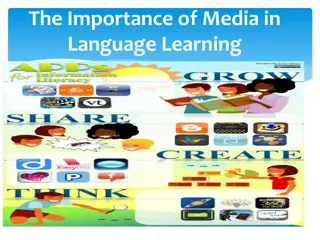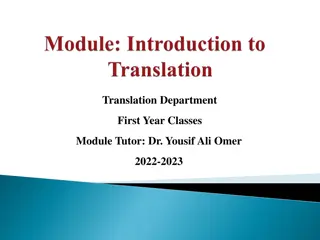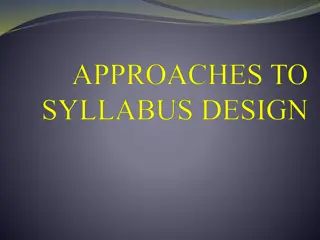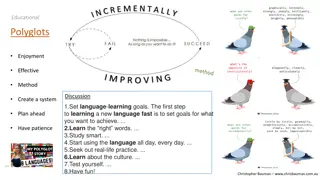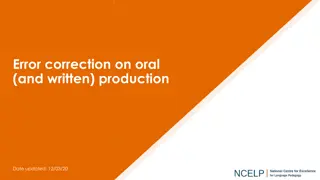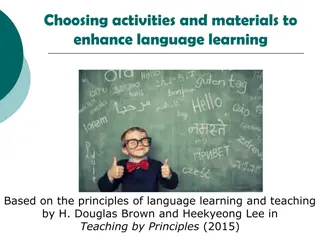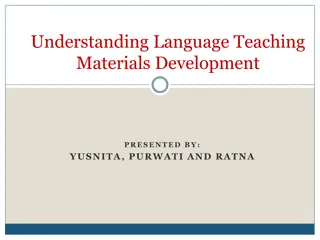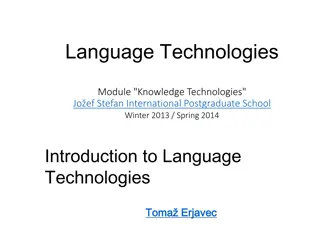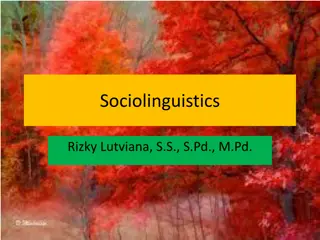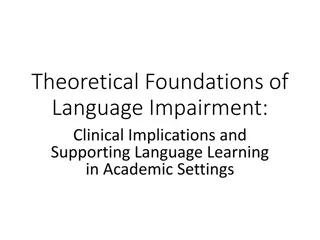Effective Language Learning Strategies
Learning a foreign language involves active engagement both inside and outside the classroom. Active learners develop positive habits to expedite the learning process by encountering new language, analyzing it, practicing regularly, and being open to experimentation and self-correction. Teachers play a crucial role in facilitating learning and guiding learners to develop good habits for effective language acquisition.
Download Presentation

Please find below an Image/Link to download the presentation.
The content on the website is provided AS IS for your information and personal use only. It may not be sold, licensed, or shared on other websites without obtaining consent from the author.If you encounter any issues during the download, it is possible that the publisher has removed the file from their server.
You are allowed to download the files provided on this website for personal or commercial use, subject to the condition that they are used lawfully. All files are the property of their respective owners.
The content on the website is provided AS IS for your information and personal use only. It may not be sold, licensed, or shared on other websites without obtaining consent from the author.
E N D
Presentation Transcript
FOREIGN LANGUAGE TEACHING AND LEARNING Dr. Mustafa Altun
In this chapter we explore: - the relationship between learning and teaching - factors which affect language learning - the language learning process - language learning aims.
Learning Learning can take place both inside and outside the classroom. It can be an informal process - picking up words from the TV, magazines, books, or friends; or it can be a formal process - attending lessons and taking part in classroom activities where language and skills are introduced and practised.
Active learners Learners can be active or passive. Active learners develop positive habits that allow them to learn more quickly and efficiently. For example, they:
- give themselves as much opportunity as possible to encounter new language. - actively notice and analyze new language and incorporate it into the language they use. - use the new language as much as possible inside and outside the classroom - take every opportunity to practise the four skills
- use study techniques, such as making vocabulary lists, to help their learning. - are prepared to experiment, make guesses, and take risks, even if this involves making mistakes. - have confidence in themselves and their ability to learn. - are aware of their own weak areas and gaps in their learning. - monitor their own language use and self-correct where necessary.
As regards learning in the classroom, learners also need to develop good habits such as: - taking an active part in activities by asking questions and initiating exchanges with other learners and the teacher. - making notes and keeping records of what has been learnt. - reviewing and consolidating. - completing homework. - coming to class on time and prepared.
TEACHING The teacher's job is to help learners learn. This relates both to the formal classroom process and learning outside the classroom. Teachers are responsible for a large amount of what happens in the classroom - what is taught, the resources used, the type and order of activities, class room management, assessment, feedback, correction, and so on. It is also part pf the teacher's job to encourage learners to take responsibility for their own learning and become 'active learners'. - understands learners' language needs and respond to them positively - designs lessons which reflect the learners' needs and develop their communicative skills
- monitors and corrects sensitively. - provides feedback and encouragement when appropriate. - tells learners not to worry about making mistakes - this is part of the learning process. - encourages good learning habits inside and outside the classroom. - keeps track of progress, gaps in learners' ability, and repeated errors. - creates an 'input-rich environment' in the classroom, for example, by putting lots of pictures with English text on the walls. - encourages learners to read English texts or listen to the radio in English.
For example the _BBC World Service Online, CDs, and audio cassettes. Television programmes, both terrestrial and digital, can also be an excellent source of input.
SCAFFOLDING One of the ways in which teachers can help learners is by providing carefully structured support. This support is sometimes described as scaffolding: the teacher supports the efforts of the learner, guiding them in the right direction, until the knowledge and understanding they have built is strong enough for the 'scaffolding' to be taken away. Scaffolded learning will involve the teacher in:
- designing activities which break down the learning task into manageable stages. - designing activities that build on previous activities. - helping learners see how the knowledge they already have is useful for making sense of the new knowledge. - deciding when learners are ready to move on to the next stage.
The scaffolding is achieved through input from the teacher, pair work, individual work, and whole-class work.
Steps Step 1 The teacher tells the class the aim of lesson - to learn how to exchange information about themselves in a conversation.
Step 2 The teacher starts by going round the class with each learner saying 'My name is ... and I live in ... '. This revises the two expressions and helps build confidence.
Step3 The teacher models the questions 'What is your name?' and 'Where do you live?' The learners repeat them. The teacher gets specific learners to ask and answer the questions. The questions are written on the board. Learners walk around the room asking and answering the questions.
Step4 The teacher models the question What is your telephone number?' Learners repeat it. The question is written on the board. Vocabulary necessary to answer the question (numbers up to 9) is revised. and written on board. Learners practice in open pairs asking 'What is your telephone number?' and answering with the right number. The learner asking the question writes down the number and the other learner checks if it is correct. Learners repeat the activity with different partners.
Step 5 The teacher uses the question 'Where do you live?' to find out how much of the vocabulary for this the learners already know; for example, 'road', 'street', 'avenue', 'square'. The teacher writes up the words they need to use in the learners' LI. Learners work with a partner to look up the English words for these in a bilingual dictionary. The teacher writes the English words from learners' answers on the board.
Step6 The teacher and selected learners model a 'question and answer' dialogue in which names, addresses, and telephone numbers are exchanged, Learners practise witha partner. The questions are left on the board at first but later rubbed off. Learners draw a table in their notebooks with the headings: name, address, and telephone. Learners exchange information with others in the class and write down their names, addresses, and telephone numbers in their notebooks. This can be used for revision and further work in another lesson.
Factors which affect language learning The relationship between teaching and learning is a key factor in whether learning takes place effectively. There are also other factors which mean that some people learn more easily and more quickly than others. Activity 3 please do on your book
Innate ability Everyone has the potential to learn a first and second language. A significant proportion of the world's population is at least bilingual - many people can speak three languages or more,
Aptitude Some people do seem to learn more easily than others. However, there is no scientific evidence that there is a biological difference in people's aptitude for learning. It is more likely to be a combination of some or all of the following factors.
Motivation One of the most important factors is how motivated learners are to learn English. Motivation can be analyzed in terms of whether it is intrinsic or extrinsic. Intrinsic motivation refers to the individual learner's wish to learn or enjoyment in learning; extrinsic motivation to a learner's need to learn because of external factors such as employment, social pressure, academic requirements, and so on. A mismatch between the two, i.e. someone who- has to learn but doesn't want to, can create problems and lead to ineffective learning.
Motivation can be supported by: - making a point of looking for texts that appeal to learners' interests - trying to create a classroom culture that encourages learners to feel confident about taking risks and using the new language - holding an open discussion with learners about the purposes of learning English, their own motivations, and their views about the task of learning a foreign language - using questionnaires or other kinds of enquiry to discover which language learning activities your learners find the most enjoyable and productive - using class questionnaires to find out what your learners' want from a course - involving learners in decisions about the classroom learning process.
Age It is widely believed that young children learn a second language more easily than older children or adults. But recent research has shown that teenagers are often the most successful language learners, and that older adults can be very successful too. Children often concentrate and learn best if they are doing a variety of activities that activate all their senses - touch, taste, smell, sight, and sound.
Proximity of L1 to English The global variety of languages means that some have a lot in common with English while others are different in many important ways. Here are some of the key features: -alphabet - sound system - written form - script and layout -grammar - social and cultural factors
Opportunity to use the target language One good way of learning is by immersion in the environment where the target language is used - being able to or having to use it in your daily life. However, many people have learnt to speak and read English very well without ever having been immersed in an English-speaking culture. If learners get lots of practice using English in the classroom, they can make significant progress.
Learning strategies As we have seen, there are a wide variety of ways the learner can speed up and improve the way they learn.
Learner types Different learners learn more effectively depending on how they are able to learn, for example:
- visual learners prefer to see words and pictures - auditory learners like listening and talking with other people - tactile learners like touching and manipulating objects - kinaesthetic learners like movement - field-independent learners like to concentrate on the details and rules
- field-dependent learners are more interested in getting across the general meaning than learning rules. reflective learners like to focus on accuracy and need time to get things right.
VAK VISUAL : perceptible by the sense of sight; visible AUDITORY : resulting from the sense of hearing KINEASTHETIC: the sensation of movement or strain in muscles, tendons, and joints; muscle sense.
Now add up how many As, Bs and Cs you selected. A s = B s = C s =
If you chose mostly As you have a VISUAL learning style If you chose mostly B s you have an AUDITORY learning style If you chose mostly C s you have a KINAESTHETIC learning style
Relationship to teaching As we have seen, the way a teacher teaches is an important factor and this also relates to learner types, for example, some learners may prefer a teacher who gives them lots of rules about the language. Other learners may prefer a teacher who encourages them to communicate freely an experiment using English.
Relationship to the teacher Personal relationships also play a big part in classroom learning. A good rapport between teacher and learner is likely to be beneficial to the learning process.
Relationship with other learners How the learner feels about the other learners in the class or group can affect language learning. It is best if learners feel comfortable with each other and are prepared to co-operate in learning. For example, if one learner dominates and doesn't give others a chance to participate, this makes learning more difficult for the less dominant individuals;
Embarrassment and anxiety Nobody likes to make a fool of themselves. in public, and learners often feel that they will do this when trying to speak or read out loud in English. But unless they try to use English to communicate, they will not learn quickly.
Self-confidence It is often easier for people who are confident in themselves to learn a language than it is for those who have low self-confidence. This is linked to fear of embarrassment' because learners who are confident will be more prepared to take risks using the new language than learners with a low level of confidence.
The language learning process The language learning process can be divided into five stages: INPUT NOTICING RECOGNIZING PATTERNS AND RULE MAKING USE AND RULE MOI)IFICATION AUTOMATING
Input First of all learners need input. Input is all the target language that a learner is exposed to, both spoken and written, inside or outside the classroom, formal or informal Sources of input can be the teacher, friends, newspapers, TV programmes, the Internet, films, coursebooks, novels, dictionaries, and so on. Some input will contain language which the learner doesn't understand and/or cannot use.
Noticing Learners will notice only some of the language they are exposed to. Some of this they will already know and some may be new. In this case the learner may notice a gap in their learning or the gap might be brought to their attention by their teacher. For example, an elementary learner might start to notice that some verbs end in '-ed'. Alternatively the teacher might decide that their learners are at the stage where they are ready to put together expressions using the past tense and introduce the '-ed' ending using a written and/or spoken text.
Recognizing patterns and rule making The learners. might then start to notice that the pattern of these verbs often refers to the past and start to develop a rule for themselves- 'verbs ending in '-ed' refer to things that happen in the past.'
Recognizing patterns and rule making In the classroom, the teacher might tell the learners the rule and then give them a chance to use it in a writing or speaking activity, for example, telling a short story. Alternatively, the teacher might give learners examples of '-ed being used in a conversation or story and encourage them to discover patterns and rules for themselves.
Use and rule modification The individual learner, having generated their own rule, starts to use the rule to produce their own sentences. As their rule does not include the exceptions of irregular verbs, they will make mistakes. They might then be corrected and modify the rule to include irregularities. Alternatively they might notice for themselves that some verbs referring to the past do not end in '-ed' and modify their rule accordingly.
Use and rule modification In the classroom the teacher has the choice of giving their learners the whole set of rules for forming verbs in the past tense or limiting the explanation to regular forms first and provide a further explanation when irregular forms start to occur in texts.
Automating Eventually the learner will be able to refer to the past using both regular and irregular verbs without consciously thinking of which ending is needed. At this point the language has become automatic - by whichwe mean that the learner is beginning to use English intuitively, more like the way they use their L1. This means that language has to be stored in the memory so that it is immediately accessible and remains there. Learners need to keep using new rules and language in order to maintain this stage.
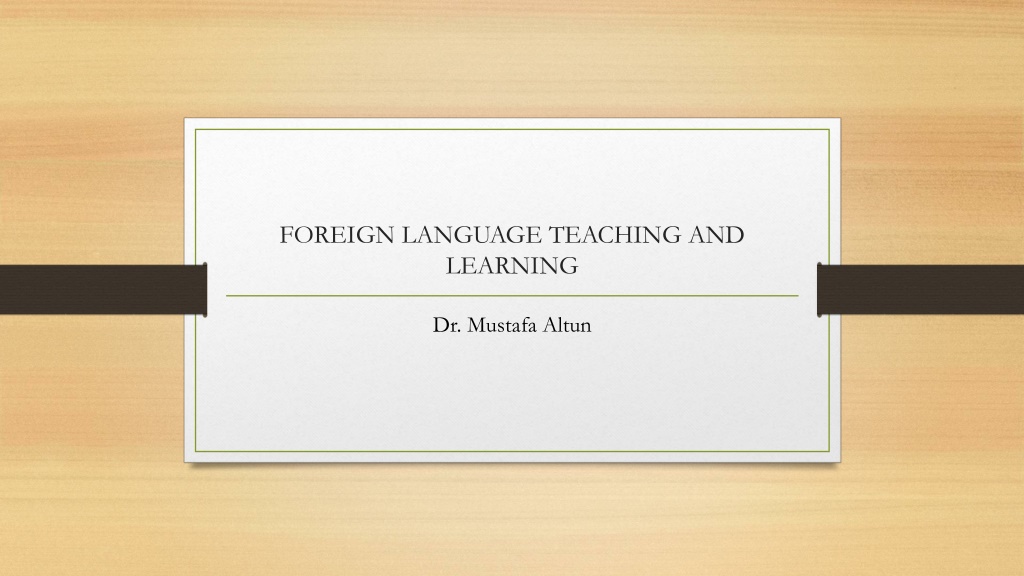
 undefined
undefined





